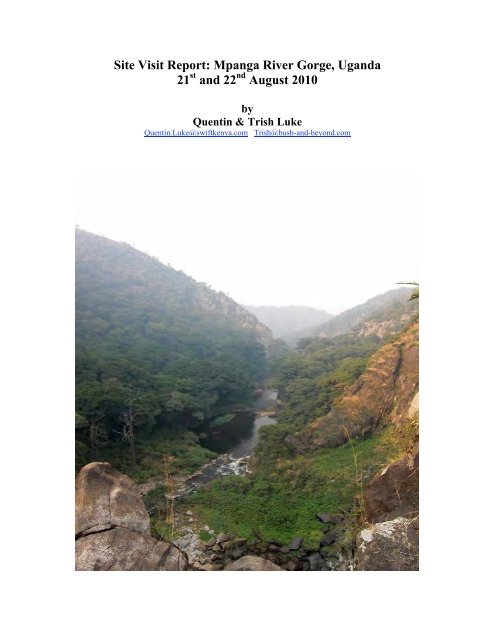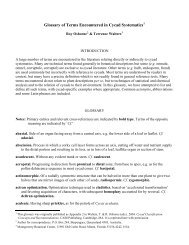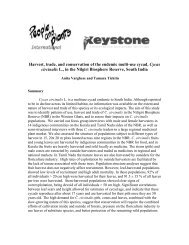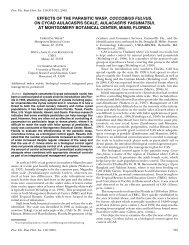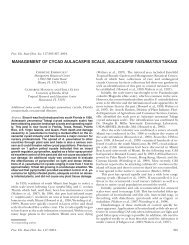Mpanga-Site-Visit-Re.. - Cycad Specialist Group
Mpanga-Site-Visit-Re.. - Cycad Specialist Group
Mpanga-Site-Visit-Re.. - Cycad Specialist Group
Create successful ePaper yourself
Turn your PDF publications into a flip-book with our unique Google optimized e-Paper software.
<strong>Site</strong> <strong>Visit</strong> <strong>Re</strong>port: <strong>Mpanga</strong> River Gorge, Uganda<br />
21 st and 22 nd August 2010<br />
by<br />
Quentin & Trish Luke<br />
Quentin.Luke@swiftkenya.com Trish@bush-and-beyond.com
Background<br />
The small (16 Megawatts) hydro-electric project at <strong>Mpanga</strong> Gorge became known<br />
outside of Uganda due to a visit by two Kenyan tourists, Steve and Jane Turner,<br />
followed by a report circulated by Andrew Roberts of Kampala through Dr Henk<br />
Beentje of the Royal Botanic Gardens, Kew.<br />
At this time (May 2008) the situation was already being investigated locally by Dr<br />
David Hafashimana, National Forestry <strong>Re</strong>sources <strong>Re</strong>search Institute, and the<br />
Uganda Wildlife Authority Executive Director in their questioning of NEMA’s<br />
(Uganda) acceptance of the Project’s very poor EIA. Following international<br />
outcry, NEMA was persuaded by the Ugandan conservationists to sign an<br />
environmental compliance agreement with the developer in which NEMA pointed<br />
out the key action areas, including protection of the cycads Encephalartos<br />
whitelockii (photo 1). No mention had been made in the EIA of the presence of the<br />
only known population of this rare species,. Much email correspondence exists<br />
regarding the outcome of UWA and Nature Uganda’s intervention and comments<br />
and advice from many well known biologists. Dr James Kalema, from Makerere<br />
University Botany Dept, made a site visit with Achilles Byaruhanga, of Nature<br />
Uganda, and filed a report on the situation in the Gorge. The contractor then<br />
agreed to actions mitigating the impact of both the road works and dam<br />
construction, and it is understood that Dr Kalema initiated several visits to the<br />
Gorge, funded by the Contractor, to establish a plant nursery, to translocate and<br />
then replant significant numbers of E. whitelockii.<br />
Photo 1. The <strong>Cycad</strong>, Encephalartos whitelockii
<strong>Site</strong> <strong>Visit</strong><br />
When QL was invited to attend an IUCN workshop in Entebbe, he took the<br />
opportunity of planning a visit to the Gorge to see the current situation with the<br />
<strong>Cycad</strong>s. Dr James Kalema made arrangements for the visit, but due to University<br />
teaching commitments was unable to accompany the team and therefore detailed<br />
his assistant, Dennis Kamoga to accompany them. The team, now consisting of<br />
QL, PL, Dr Wendy Foden, Programme Officer (Climate Change) of IUCN Species<br />
Programme and DK, set out for <strong>Mpanga</strong> from Kampala on the morning of 21 st<br />
August and arrived at Kamwenge in the afternoon. A representative of the<br />
contractor, Mr LPD Dayanandra had been waiting for the team and returned to the<br />
Gorge with them in the late afternoon. The dam site was visited first (photo 2)<br />
where the small scale of the dam wall was noted. The most shocking sight was the<br />
large area of grassland occupied by cycads, that had been recently burnt by the<br />
local owners of the eastern side of the Gorge (pers comm. Dayanandra – photo 3).<br />
An attempt by the contractor to remove some of the bigger cycads from an island<br />
within the impoundment area was evidently in progress (photo 4). The minimum<br />
flow (during the dry season) along the river from the dam to the falls and down to<br />
the powerhouse is set by two pipes in the dam wall of 450mm diametre each (one<br />
shown marked in red in photo 5). A very brief visit (as it was getting dark) was<br />
made to the powerhouse, a few kilometres down river, followed by a brief visit to<br />
the contractor’s staff encampment on a ridge overlooking Lake George.<br />
Photo 2. <strong>Mpanga</strong> Dam Wall
Photo 3. Local Burning of <strong>Cycad</strong>s<br />
Photo 4. <strong>Cycad</strong> removal from Island in Impoundment Area
Photo 5. Minimum Flow provision in Dam Wall<br />
The team returned to Kamwenge village for the night (some 25 km away) and<br />
arranged to meet the contractor at 6.30am the following morning.<br />
On the morning of 22 nd August, the team met Dayanandra who gave his permission<br />
to visit the Gorge unaccompanied. The first area visited was the rock blasting for<br />
the continuation of the water channel (photos 6) where a group of red colobus were<br />
encountered. Finding a path down to the river, QL began a basic plant list<br />
(Appendix 1) and the team was able to get to the top of the <strong>Mpanga</strong> Falls (photo 7).<br />
The team then returned to the powerhouse and walked up river to some smaller<br />
falls and later looked at the Gorge further down river (photo 8). Various areas due<br />
for replanting of cycads from the nursery (photo 9) were visited and the sorry state<br />
of the nursery recorded (photo 10). After lunch in Kamwenge, we said goodbye to<br />
Dyanandra and left for the return trip to Kampala.
Photo 6. Routing of Water Channel<br />
Photo 7. Top of <strong>Mpanga</strong> Falls
Photo 8. River below <strong>Mpanga</strong> Powerhouse<br />
Photo 9. Area prepared for <strong>Cycad</strong> planting
Photo 10. <strong>Cycad</strong> Nursery<br />
Observations<br />
1. Efforts by the contractor to translocate cycads had come to a halt due to<br />
intense pressure to complete the dam construction and power generation<br />
contract by October 2010 resulting in all personnel working day and night.<br />
The Makerere team had also not visited the site for 3 months because the<br />
contractor had said that they needed to complete the construction of the<br />
canal before they could spare any personnel for cycad replanting.<br />
2. The large area of cycads on the eastern side of the Gorge had been burnt by<br />
local landowners apparently as part of their normal farming practice of grass<br />
regeneration for their livestock (photo 11) and was commented on strongly<br />
by the contractor as a major impact on the cycad population.<br />
3. <strong>Cycad</strong>s in the nursery and those already replanted in the Project area were<br />
not all doing well due a certain lack of care and attention.<br />
4. Damage to mature cycads was ongoing as a result of continued project<br />
earthworks (blasting) and construction (photo 12).
Photo 11. Local Cow (Ankole)<br />
Photo 12. <strong>Cycad</strong> Damage<br />
5. The actual area of cycads impacted by the construction is probably less than<br />
5% of the total area inhabited by the cycads.
6. As reported by others, the Gorge is indeed a stunning natural landscape and<br />
would undoubtedly, if managed as a tourist attraction, provide more income<br />
and benefit to the local community in the long term than the short term gain<br />
of the hydro electric project. It should be noted that, according to the<br />
contractor, the local population were still negotiating for some of the<br />
generated power to be made available on site and not all transmitted to the<br />
national grid (at present power only reaches as far as Kamwenge) .<br />
7. A new development that apparently had not been part of earlier discussions<br />
or EIA, was the provision of the transmission lines by another contractor<br />
who was obviously not aware or not interested in minimizing impact on the<br />
cycads (photo 13, 14).<br />
Discussion<br />
Photo 13. Power Line route clearing<br />
With the above in mind, it is obvious that after the initial flurry of activity to<br />
prevent uncontrolled damage to this unique population of cycads, economic<br />
pressure on the contractor and lack of supervision, has led to more damage than<br />
necessary. Urgent intervention through emergency funding could resolve the
situation over translocations of the cycads and secure the necessary oversight.<br />
However, the continued lack of local conservation initiative and what appears to be<br />
no change in long term planning for the area, means that the cycads still have a<br />
very uncertain future and a superb asset for the Ugandan people is still being<br />
undervalued.<br />
Photo 14. Chainsaw operation on <strong>Cycad</strong>s<br />
The most surprising discoveries of this survey were that no complete botanical<br />
inventory has been carried out (neither within the impoundment area nor below the<br />
dam), thus it is unknown what other species of conservation concern exist within<br />
the Gorge. Nor have any baseline vegetation studies been carried out so that the<br />
impact of the reduction in the dry season flow (to 1 cumec along the section of the<br />
Gorge from the dam to the power house) will not be measurable in the future. It is<br />
still not too late to complete these studies before the project becomes operational<br />
(probably not before December 2010). It is probable that knowledge of the other<br />
sections of biodiversity is equally poor and that mammalogy, ornithology,<br />
herpetology and invertebrate studies are still necessary (certainly no census has<br />
been carried out on the <strong>Re</strong>d Listed <strong>Re</strong>d Colobus, Procolobus rufomitratus<br />
tephrosceles). Although the initial impression was that the Cynometra forest<br />
(photo) was not very plant species rich, it is not known what else it shelters and<br />
whether it will be impacted by the unforeseen effects of the project (Photo 15).
Photo 15. Tree in <strong>Mpanga</strong> Gorge, Baphia wollastonii<br />
Acknowledgements<br />
Thanks are due to: the IUCN Albertine Rift Climate Change Vulnerability<br />
Assessment Workshop for funding QL’s vehicle from Nairobi to Entebbe and back;<br />
and to the Fairchild Tropical Botanic Garden for supporting the trip from Kampala<br />
to <strong>Mpanga</strong> and back. The trip would not have been possible without Dr James<br />
Kalema’s organisation and Dennis Kamoga’s cheerful company. The co-operation<br />
of the contractor, through Mr Dayanandra, is recognised.<br />
<strong>Re</strong>ferences<br />
Byaruhanga A., J. Kalema & A. Namara (2008). The Impact of Dam Construction on the<br />
Biodiversity and Ecology of <strong>Mpanga</strong> River Gorge, Kamwenge District, Western Uganda.<br />
Unpublished <strong>Re</strong>port<br />
APPENDIX: 1<br />
Preliminary List of Plants from <strong>Mpanga</strong> Gorge<br />
FAMILY SPECIES<br />
Polypodiaceae Phymatosorus scolopendria (Burm.f.) Pic.Serm.<br />
Polypodiaceae Platycerium elephantotis Schweinf.<br />
Zamiaceae Encephalartos whitelockii P.J.H.Hurter<br />
Capparaceae Capparis tomentosa Lam.<br />
Capparaceae Maerua duchesnei (De Wild.) F.White<br />
Crassulaceae Kalanchoe sp
Polygonaceae Persicaria decipiens (R.Br.) K.L.Wilson<br />
Balsaminaceae Impatiens niamniamensis Gilg<br />
Canellaceae Warburgia ugandensis Sprague ssp ugandensis<br />
Achariaceae Rawsonia lucida Harv. & Sond.<br />
Begoniaceae Begonia sp<br />
Ochnaceae Ochna sp<br />
Combretaceae Combretum collinum Fresen. ssp binderanum?<br />
Combretaceae Combretum molle G.Don<br />
Combretaceae Combretum sp<br />
Malvaceae Hibiscus calyphyllus Cav.<br />
Euphorbiaceae Alchornea cordifolia (Schumach. & Thonn.) Muel.Arg.<br />
Euphorbiaceae Argomuellera macrophylla Pax<br />
Euphorbiaceae Euphorbia dawei N.E.Br.<br />
Euphorbiaceae Synadenium sp<br />
Caesalpiniaceae (Leguminosae) Cynometra alexandri C.H.Wright<br />
Mimosaceae (Leguminosae) Mimosa pigra L.<br />
Papilionaceae (Leguminosae) Baphia wollastonii Baker f.<br />
Papilionaceae (Leguminosae) Craibia brownii Dunn<br />
Hammermelidaceae Trichocladus ellipticus Eckl. & Zeyh. ssp malosanus (Baker) Verdc.<br />
Moraceae Dorstenia hildebrandtii Engl. var schlechteri (Engl.) Hijman<br />
Moraceae Ficus exasperata Vahl<br />
Moraceae Ficus sp cf amadiensis De Wild.<br />
Urticaceae Obetia radula (Baker) B.D.Jackson<br />
Urticaceae Urera trinervis (Hochst.) Friis & Immelman<br />
Celastraceae Gymnosporia senegalensis (Lam.) Loes.<br />
Celastraceae Maytenus undata (Thunb.) Blakelock<br />
Loranthaceae Agelanthus toroensis (Sprague) Polhill & Wiens<br />
Vitaceae Cissus oliveri (Engl.) Gilg?<br />
Rutaceae Vepris sp<br />
Sapindaceae Dodonaea viscose Jacq. var angustifolia (L.F.) Benth.<br />
Anacardiaceae Pseudospondias microcarpa (A.Rich.) Engl.?<br />
Anacardiaceae Searsia natalensis (Krauss) F.A.Barkley<br />
Sapotaceae Mimusops bagshawei S.Moore<br />
Myrsinaceae Maesa lanceolata Forssk.<br />
Loganiaceae Strychnos usambarensis Gilg<br />
Asclepiadaceae (Apocynaceae) Ceropegia sp<br />
Asclepiadaceae (Apocynaceae) Cynanchum gerrardii (Harvey) Liede?<br />
Asclepiadaceae (Apocynaceae) Telosma africana (N.E.Br.) N.E.Br.<br />
Asteraceae Ageratum conyzoides L.<br />
Asteraceae Solanecio mannii (Hook.f.) C.Jeffrey<br />
Boraginaceae Cordia monoica Roxb.<br />
Solanaceae Solanum giganteum Jacq.?<br />
Convolvulaceae Stictocardia beraviensis (Vatke) Hallier f.<br />
Lamiaceae Plectranthus sp<br />
Asparagaceae Asparagus setaceus (Kunth) Jessop<br />
Dracaenaceae Sansevieria 1<br />
Dracaenaceae Sansevieria 2<br />
Anthericaceae Chlorophytum sp<br />
Amaryllidaceae Scadoxus multiflorus (Martyn) Raf. ssp multiflorus<br />
Orchidaceae Calyptrochilum christyanum (Rchb.f.) Summerh.<br />
Orchidaceae Tridactyle sp?<br />
Orchidaceae Vanilla imperialis Kraenzl.?<br />
Araceae Anchomanes difformis (Blume) Engl.<br />
Arecaceae Phoenix reclinata Jacq.


